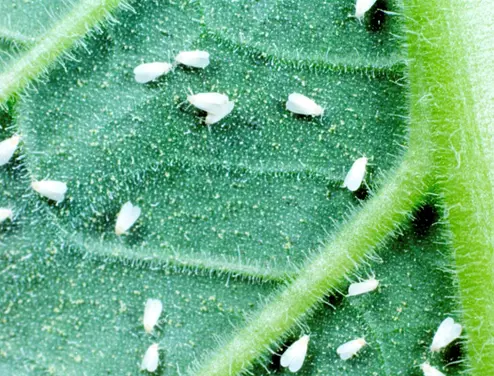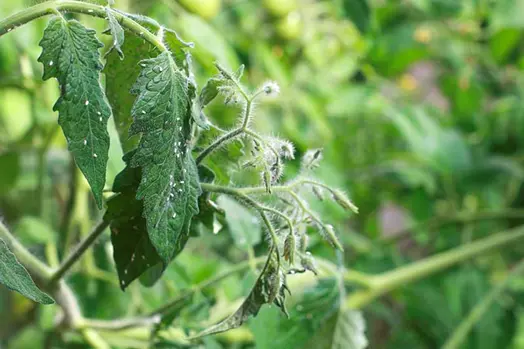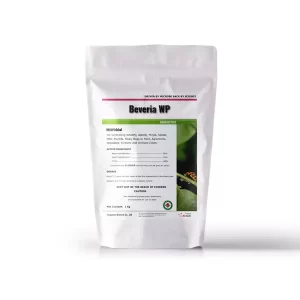Whenever we talk about gardening, plants in our garden, one thing that trigger panic button is pest! Is it hard to control whiteflies? this is why organic whitefly control article is out there for you!
Whiteflies are small, winged insects that are common pests of vegetables, fruits, and ornamental plants. Named after the white, waxy substance that covers their bodies and wings, white bugs pose a threat to plants as they feed on their sap. This feeding behavior leads to leaf yellowing, wilting, and stunted growth. Additionally, they are capable of transmitting viruses, further exacerbating the damage to plants. Due to their rapid reproduction and resilience, controlling these pests becomes a challenging task in gardens and greenhouses alike.

You can identify a white fly infestation by several visible signs. White bugs, which are about the size of a grain of rice, often form clusters on the undersides of leaves. They may be visible to the naked eye or may require the use of a magnifying glass. They feed on the sap of plants, which cause yellowing and wilting of leaves. Affected leaves may appear pale or yellow and may droop or hang down limply. They also cause reduced growth which may appear smaller or less robust than healthy crops. In addition, They secrete a sugary substance called honeydew as they feed on crops. This honeydew attract other pests and also encourage growth of sooty mold, a black, soot-like fungus that coat leaves and stems. If you notice any of these symptoms, it is worth checking for white bug presence. An infestation cause significant damage to crops and should be addressed as soon as possible in order to protect health and productivity of garden.
There are over 1500 species of whiteflies to deal with! Want to understand whites pest control organically? It is easy if you know the following tips:
Some beneficial insects, such as ladybugs, lacewings, and parasitic wasps, prey on white bug and help reduce their populations. To encourage these natural predators, you can plant flowers that attract them or purchase them from a garden supply store and release them into your garden. But avoid using pesticides that may harm natural predators.
You can use fine mesh screens or row covers to physically block access. Place barriers over crops or around garden bed, depending on size and location of infestation. Keep barriers in place until the population has been controlled.
If you have a small infestation, you can remove and dispose of infested plants. Carefully cut or pull infested parts, being sure to remove as much of root system as possible. Avoid shaking or rubbing plants, as this can lead spread to other ones. Place infested plants in a plastic bag and seal it tightly. Sanitize your tools after removing them to prevent spread of white bug. Monitor for new infestations and take steps to treat them as soon as they are detected.
You can purchase or make your own yellow sticky traps to help monitor in whites pest control. You can place these traps near infested plants to help trap adult bugs before they lay white insect eggs on leaves. Monitor traps for their presence to help determine severity of infestation and effectiveness of treatment.
Proper watering, fertilizing, and pruning help keep your crops healthy and more resistant to pest infestations.

In some cases, insecticide is necessary to use if whitefly population increasing. The following whitefly insecticides are recommended :

Beauveria Bassiana is a fungus that infect and kill them naturally. When Beauveria bassiana infects a white fly on crops, it grows inside pests’ body and eventually kills it. The fungus produces enzymes that break down insect’s cuticle (outer protective layer), allowing it to enter insect’s body. Once inside, the fungus begins to grow and reproduce, eventually filling pests’ body cavity and disrupting its normal functions. The infected insect may show symptoms such as loss of mobility and abnormal behavior, and it will eventually die as a result of infection.
In addition to directly killing them, Beauveria bassiana can also indirectly control them by reducing their reproduction and population size. The fungus reduce lifespan of pests and reduce white insect eggs on leaves.
Beweria WP is the best organic insecticide for white bugs, formulated by Beauveria Bassiana, effective whites pest control in indoor and outdoor. Apply the mixture using a sprayer or duster. Make sure to thoroughly coat undersides of leaves, as this is where they tend to feed and lay eggs. Reapply it every 7-14 days, or according to manufacturer’s instructions, until whitefly population is under control. People generally consider Beweria WP to be safe for humans and the environment, which makes it a good alternative to chemical insecticides for controlling them in organic agriculture.
Metarhizium anisopliae is another fungus that infect and kill white bug and other pests. Like Beauveria bassiana, Metarhizium anisopliae is a type of fungus that can be used as a whitefly pesticide. The naturally occurring fungus is found in soil and crop debris and infects insects through contact or ingestion. When the fungus infects a pest, it grows inside insect’s body and eventually kills it.
Myco Pestop is organic pesticide for whiteflies, with active ingredient Metarhizium Anisopliae, oil dispersant formulation. Once applied, Myco Pestop continue to help get rid of pests for several weeks or months. Controlling white fly on plants that reproduce quickly can be especially useful for this purpose. It is safe for humans and environment, making it a good choice for use in home gardens and other areas where people and pets may be present.
People commonly use neem oil, derived from the seeds and leaves of the neem tree (Azadirachta indica), to get rid of a wide range of insect pests. Neem oil for whiteflies works by disrupting normal physiology of insects, which cause them to stop feeding, lay fewer eggs, and eventually die.
You can use several ways to control white bugs. One method is to apply it directly to infested crops. People can control white bugs by using foliar sprays or by applying it to the soil. The active ingredients in neem oil, azadirachtin and other limonoids, are toxic to insects when ingested or absorbed through cuticle.
When applied to crops, it can also create a physical barrier that makes it difficult for insects to land and feed on plant. In addition, the strong smell can deter some insects from feeding on treated crops.
Insecticidal soap is a type of soap that is specifically formulated to kill insects on contact. It works by breaking down insects’ outer exoskeleton, causing them to dehydrate and die. Apply the products as a spray or incorporate them into soil, depending on the specific product and the application method recommended. Reapply the products as needed. Just be sure to follow manufacturer’s instructions for use, as some plants may be sensitive to these products.
Pyrethrin is a biological pesticide that is derived from flowers of pyrethrum plant (Chrysanthemum cinerariifolium). It is commonly used to control a wide range of pests. Pyrethrin works by disrupting the nervous system of pests, which can cause them to stop feeding, become paralyzed, and eventually die.
Apply a pyrethrin formulation directly to infested plants . This can be done through foliar sprays or by applying the pesticide to soil. The active ingredients in pyrethrin, pyrethrins and pyrethoids, are toxic to white bug and other insects when ingested or absorbed through the cuticle.
However, it is important to follow the label instructions and use caution when applying whites pest control product, including pyrethrin. Pyrethrin can be harmful to beneficial insects and other non-target organisms, and it can break down quickly in environment, so it is vital to carefully consider the potential impacts of using pyrethrin in your pest management strategy.
It is necessary to consider the specific needs of your garden and plants you are trying to protect when deciding which organic whitefly control method to use. It is highly recommended to rotate or combine using of different methods to reduce the risk of whiteflies.
As a plantation owner, I face quite a few..
The banana weevil, also known as Cosmopolites sordidus, is..
Fusarium wilt in banana is usually known to be..

Leave a Reply